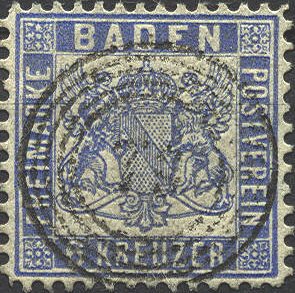
Fournier forgery of the 6 k with a different perforation. The cancel '79' is also forged.
Return To Catalogue - Baden 1860-1868 - Germany
Currency: 60 Kreuzer = 1 Gulden
Note: on my website many of the
pictures can not be seen! They are of course present in the cd's;
contact me if you want to purchase them: evert@klaseboer.com.
Fournier forgeries:

Fournier forgery of the 6 k with a different perforation. The
cancel '79' is also forged.
Fournier has made forgeries of these stamps, they have a different perforation (as far as I have seen). The Serrane Guide mentions that they were made with the help of the engraver V. (Venturini?) from Turin. I do not know if there are any differences in the design compared to a genuine stamp. I've seen all values of this serie forged by Fournier. In the Fournier album of philatelic forgeries, the above cancel is given ('79' in 5 concentric circles) as well as '60' in 5 concentric circles, '8' in 5 concentric circles (see example below), '31' in 3 concentric circles, 3 concentric circles and a dot in the middle, an '8' in a small circle, three circular cancels with 'KEHL 2 NOV 6-7 N', 'RASTATT 14 OCT 5-10 V' and 'FURSTENBERG 17 2 MBG'. I have furthermore seen 'KARLSRUHE 2 Mrz' in two straight lines. The cancel "109" in 5 concentric lines is listed under Bavaria in the Fournier album, however I have seen this cancel on Baden (see below for examples). Apparently, the cancel "12" in 5 concentric lines, which was also listed there, can also be found on these Baden forgeries (see example on the 3 k forgery below).
All values (except 18 kr) can be distinguished by a break at the bottom right of the upper left hand ornament.
The 18 kreuzer's main distinguishing characteristic is its perforation.

The Fournier forged cancels as they can be found in 'The Fournier
Album of Philatelic Forgeries'. Another cancel 'KARLSRUHE 2 Mrz'
and date in two straight lines can also be found in this album
(no image available yet). These forged cancels were according to
the Serrane Guide also used on genuine postage due stamps,
genuine stamps and forged postal stationary.
On http://www.stampsx.com/ratgeber/stempelliste-falsch.php a forged '79' Lahr cancel can be seen applied to a 6 kr Thurn and Taxis stamp. It might be a Fournier product.
Other examples of Fournier forgeries:
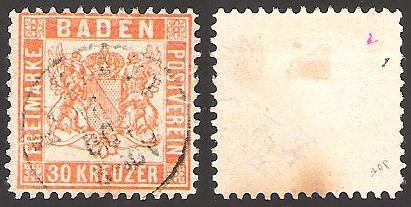
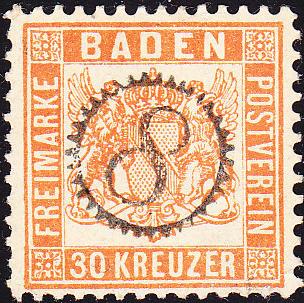
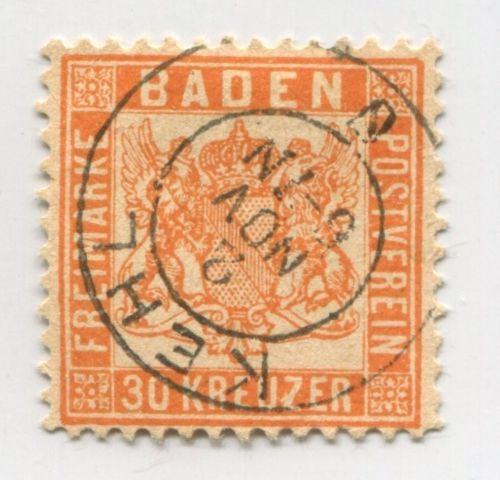
This Fournier forgery of the 30 k value has the forged
"RASTATT 14 OCT 5-10 V" cancel. Next to it a Fournier
forgery with a forged "8" cancel as shown above. Also a
"KEHL 2 NOV 6-7N" cancel. Note the white break in the
lower right hand side of the upper left corner ornament.
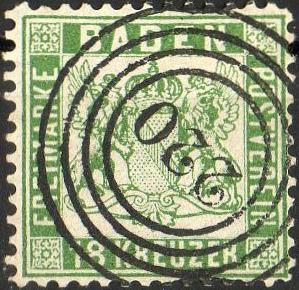
Other forgery of the 18 k with '220' four-ring cancel (image
obtained thanks to Eric Aulagner). In my view, this is not a
Baden cancel (it also does not appear in the Fournier Album).
According to the Serrane guide, the leaf pattern below the shield
and the upper right hand corner are different.
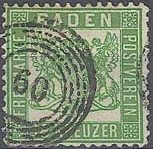
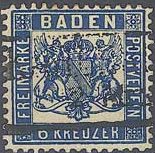
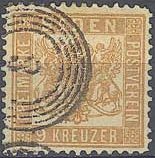
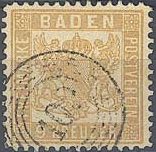
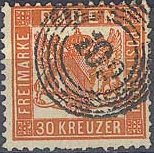
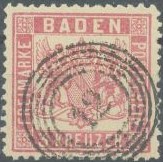
Reduced sizes; Note the '109' cancel, which does not appear in
The Fournier Album.
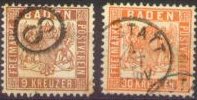
(Fournier forgeries with '8' in a small circle cancel and Rastatt
cancel, reduced sizes)
Fournier is known to have made forgeries of the 30 kr. He took ordinary 3-kreuzer stamps of the 1862 issue, where the colour was chemically removed, and later reprinted it in orange, from a forged engraving of the rare 30-kreuzer value. During the two operations, the cancellation was not removed. So, these forgeries have the paper, perforation and cancellation genuine and are very dangerous! Fournier seems to have considered this forgery one of his masterpieces (this text is translated from Serrane, in the french introduction of the 'Fournier album of philatelic forgeries'). A similar text can also be found in the Serrane Guide. The Serrane Guide also mentions that the 18 kreuzer was forged in a similar fashion.
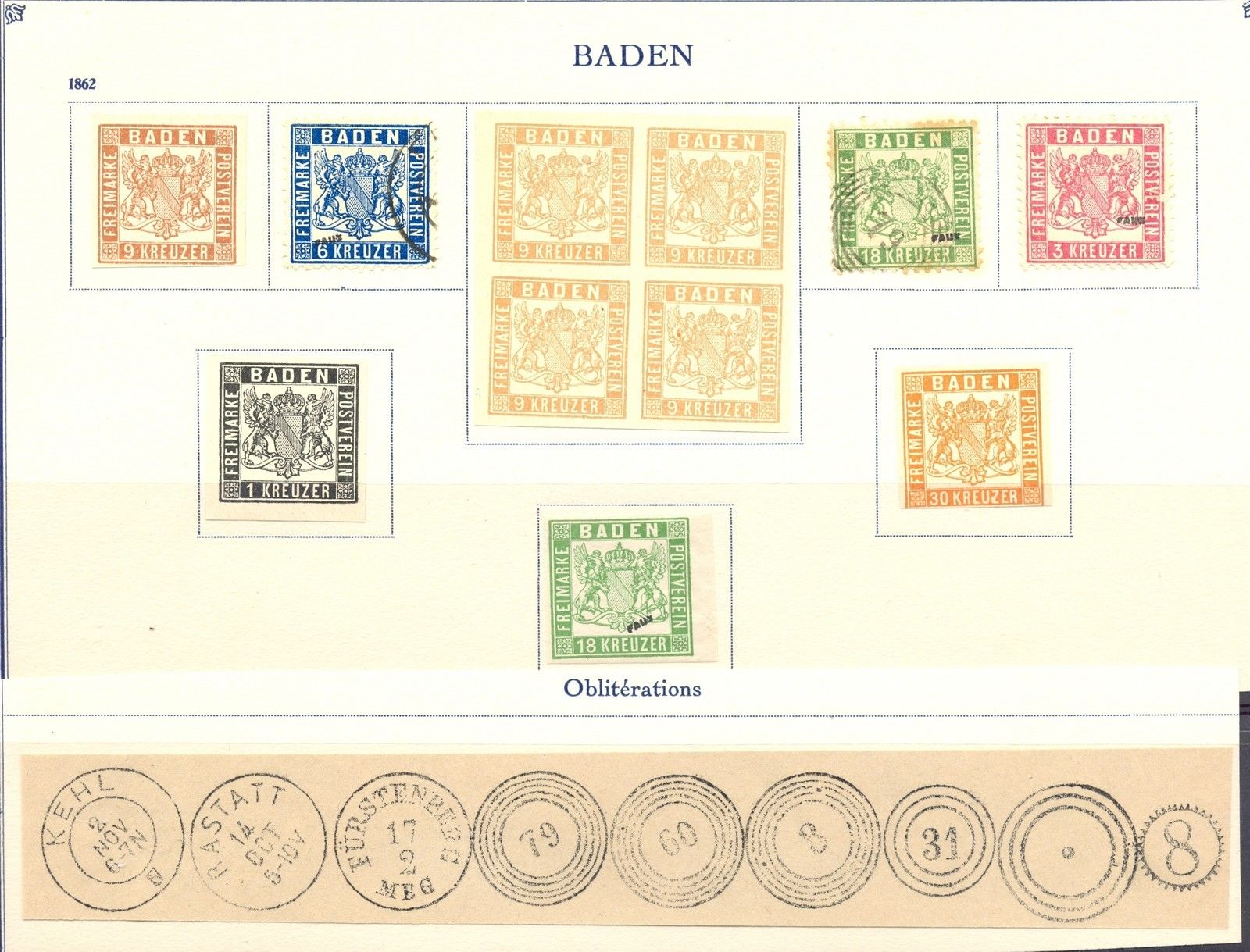
A page from a Fournier Album of Philatelic Forgeries.
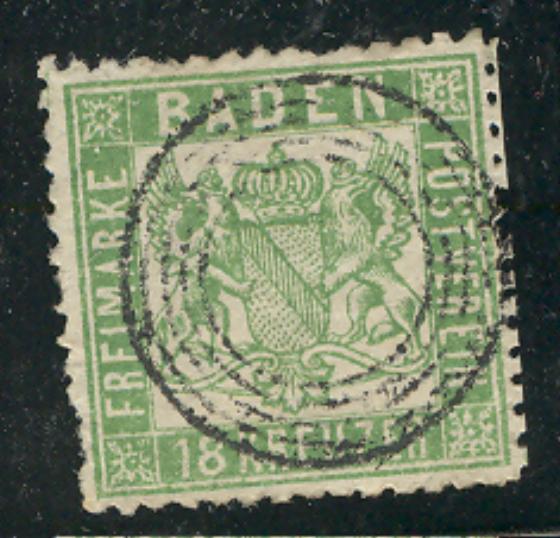
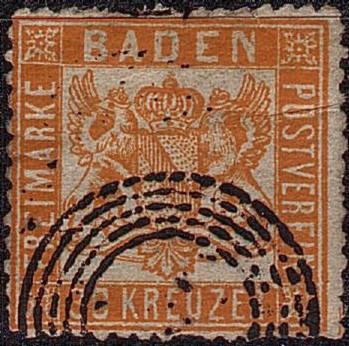
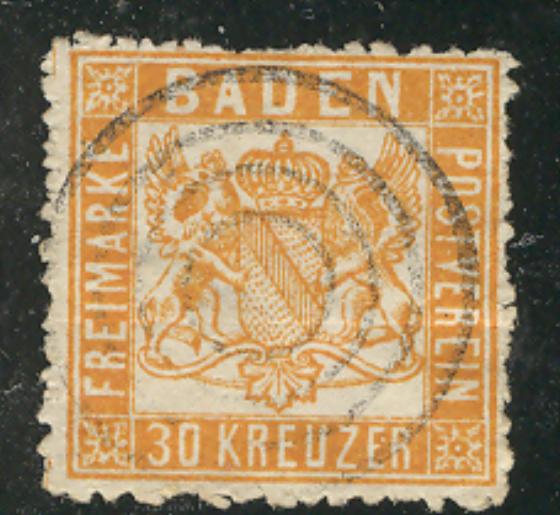
A forged 18 k and two forged 30 k stamps with forged cancels; the
arms design almost touches the bottom frame, the lettering is
also slightly different from the genuine 30 k stamps (see for
example the much thinner 'E's in 'KREUZER'). The perforation is
very rough, the corner ornaments have too much colour and the
dots in the shield are unevenly distributed. Note the concentric
cancels without numerals on these forgeries (I've seen the widely
spaced 4-ring cancel on the 18 k as well).
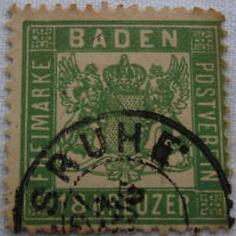
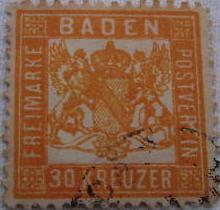
Two forgeries of the 18 kr and 30 kr made by the same forger. The
wings are too close to the borders when compared to a genuine
stamp. These forgeries are probably of Italian origin.
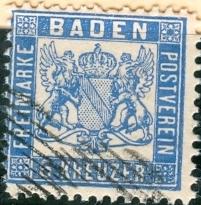
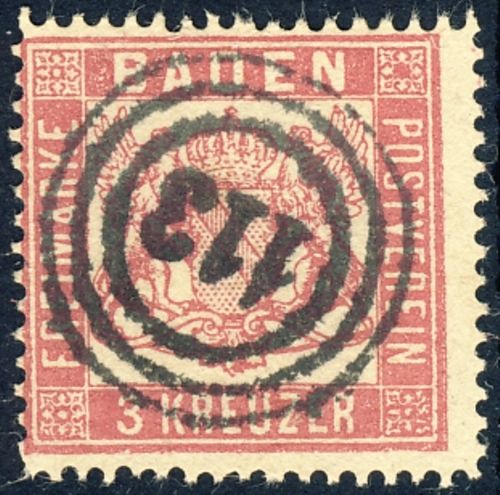
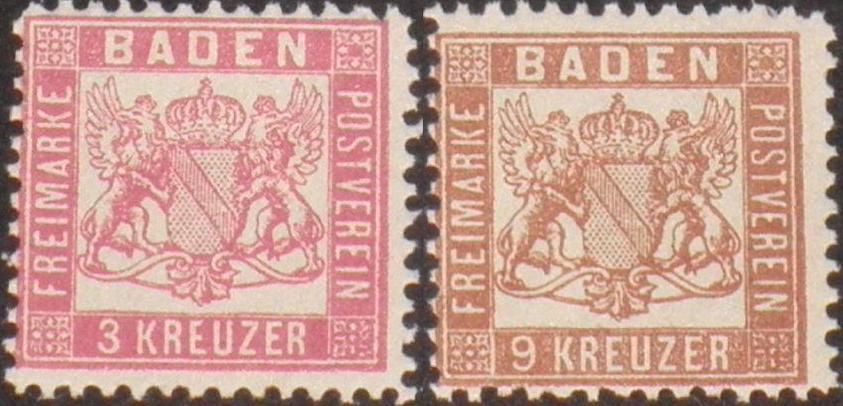

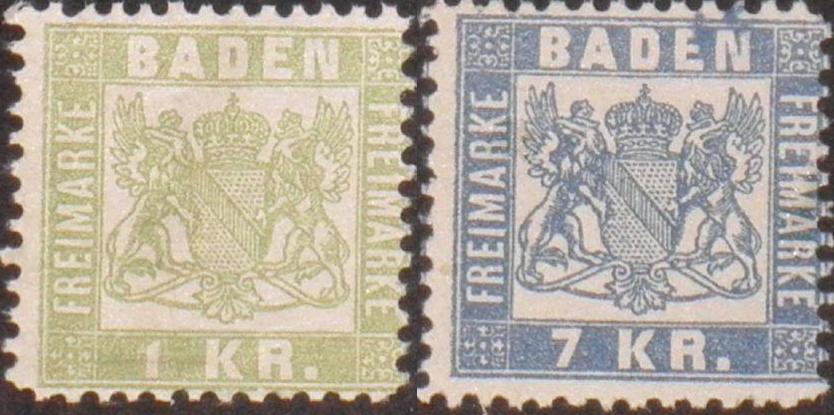
Another set of forgeries, the perforation doesn't match in the
corners. The 'B' of 'BADEN' has an extension at the right hand
top side. The cancel on the 6 k was never used in Baden. The '3'
in the 3 k value is totally different from a genuine 3 k stamp.
The 1 k and 7 k values of the next issue were also made by the
same forger. I've also seen the 3 k value of this forgery with
perforation 13 1/2 (with a ring cancel).
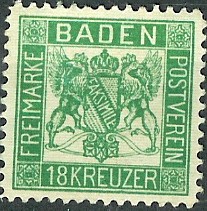
(Inscription 'FAKSIMILE' in the shield)
The above 18 k stamp has the inscription 'FAKSIMILE' on the central part of the arms. I've also seen this forgery with the word 'FAKSIMILE' scratched out (but still faintly visible).
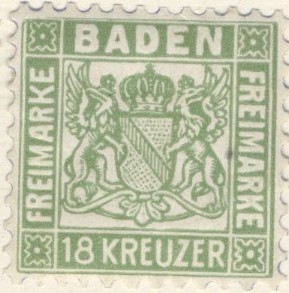
A forgery of the 18 k with 'FREIMARKE' in the left and right hand
side ('POSTVEREIN' should have been written at the right hand
side of the stamp).
Sperati forgeries:
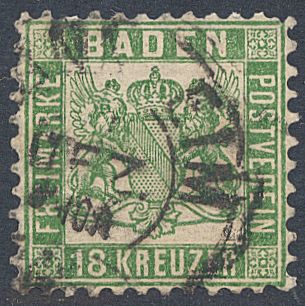
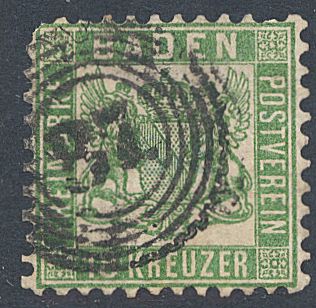
Three Sperati forgeries.
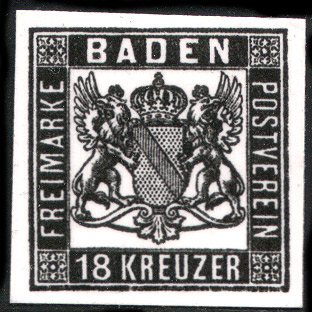
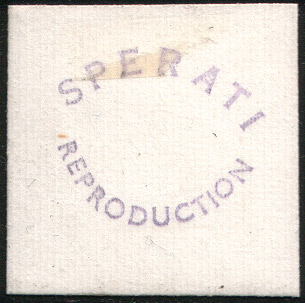
Front and backside of a blackprint of a 18 k Sperati forgery.

Forged Sperati 'proof' of the 18 k stamp
The cancels on the Sperati forgeries are always genuine (he bleached out the design of a lower value genuine stamp while retaining the cancel and printed the 18 k design on top of it). To make things even more complicated, Sperati made four different kinds of forgeries of the 18 k value (Reproduction 'A' to 'D'). These forgeries are extremely deceptive. If my information is correct, Reproduction 'A' has a small white dot in front of the 'F' of 'FREIMARKE' and a coloured dot in the lower left part of the second 'E' of this word. Reproductions 'B' and 'D' have a small dot between the 'A' and 'D' of 'BADEN'. Reproduction 'C' has a small white dot between the 'E' and 'I' of 'POSTVEREIN'.
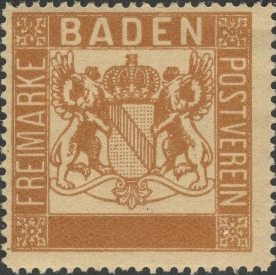
The above stamp doesn't have any value inscription. The inscriptions are different from the genuine stamps. I have also seen this label in blue and orange. The size of this label is larger than the genuine stamps (about 1 1/2 times). I've been told that it was made by A.C. Roessler, who overprinted these labels with advertising messages. He also sold unoverprinted labels to other dealers. I've seen such abels in blue and orange with a black overprint 'WE SELL THE AMERICAN HINGE 15 c per 1000', also a blue label with 'WE TAKE SUBSCRIPTIONS to ROESSLER'S STAMP NEWS' in black.
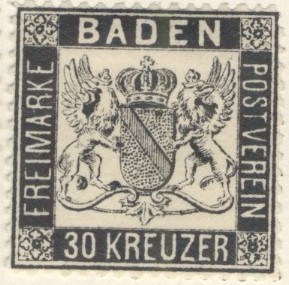
Forged 30 k stamp in the color black.
Peter Winter forgeries of the Stockach imperforate issue:

Imperforate forgery on envelope, note that this (forged) envelope
was also used to create forgeries of Bavaria. This envelope has a
cancel 'STOCKACH 28 DEZ'.
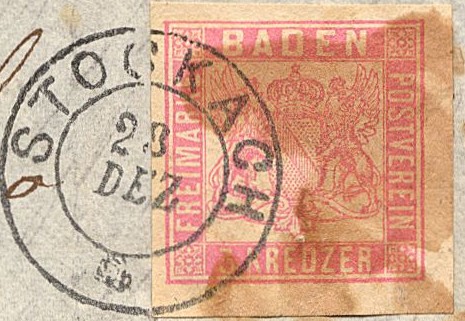
Zoom-in on the forged stamp and forged cancel
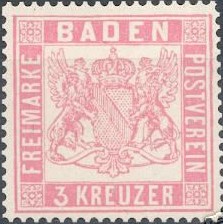
Perforated Winter forgery, pretending to be the rare perforation
13 1/2. The perforation does not seem to match the genuine
perforation.
The 3 k imperforate stamp was forged by Peter Winter (with cancel 'STOCKACH 28 DEZ' or uncancelled as shown above). I have also seen two perforated uncancelled tete-beche stamps and a partly perforated (upper perforation missing) uncancelled 3 k stamp. They are also printed on white modern paper. I presume they are all coming from the same source (i.e Peter Winter). Usually the word 'Replik' is printed in small letters on the back. Also note the small imperfections in the upper left (red extension to the left) and upper right (frame has a thin spot) corners.
Forged cancel:
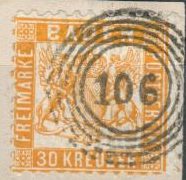
(Forged cancel on a genuine 30 k stamp, reduced size)
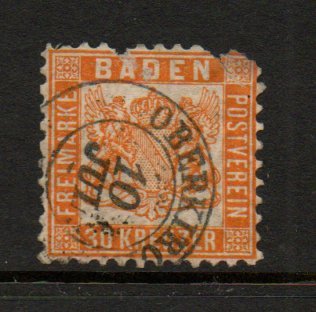
Possibly a Rudolph Thomas forgery with 'OBERKIRCH 10 JUL' cancel.
Other forged cancels were made by Rudolph Thomas from Chicago (see
'Philatelic Forgers, their Lives and Works' by V.E.Tyler,
probably to 'enhance' some 30 k stamps), the following cancels
(with fixed dates) are known:
'OBERKIRCH 10 JUL'
'GRIESSEN 7 OCT
'STOCKACH 7 OCT'
These cancels were used somewhere between 1912-1941 (Thomas died
in 1941). If anybody has more information, please contact me!
Some imperforate forged 18 k stamps (or reprints?) in different fancy colors:
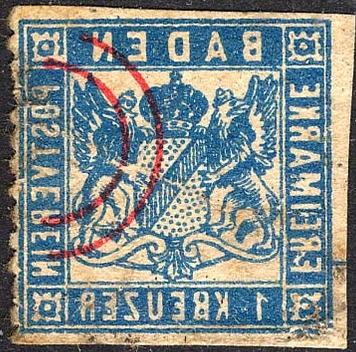
1 Kr blue inverted image with red cancel. This is a transfer
picture or 'Abziehbild' or 'decalcomanie' to be used as a toy and
transferred on a child's arm made by Zechmeyer.
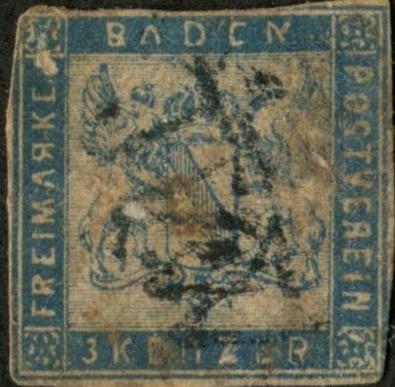
A very primitive 3 k blue forgery.
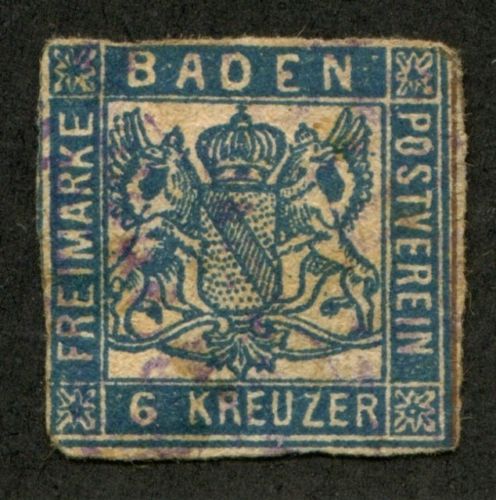
Another very primitive 6 k blue forgery.
Stamps - Briefmarken - Timbres-Poste